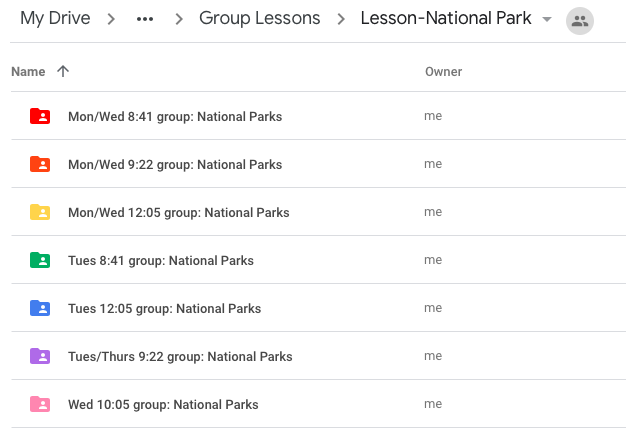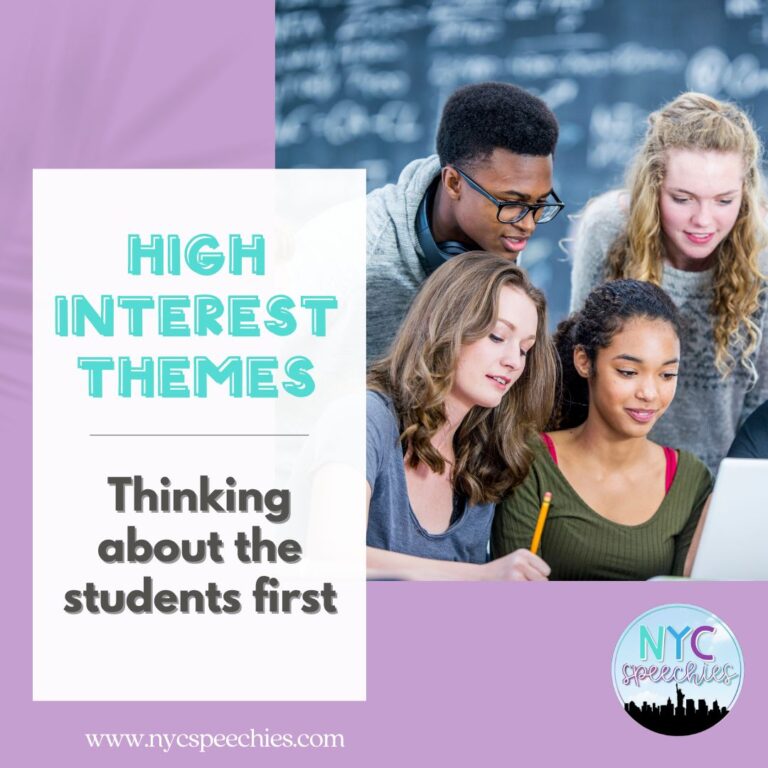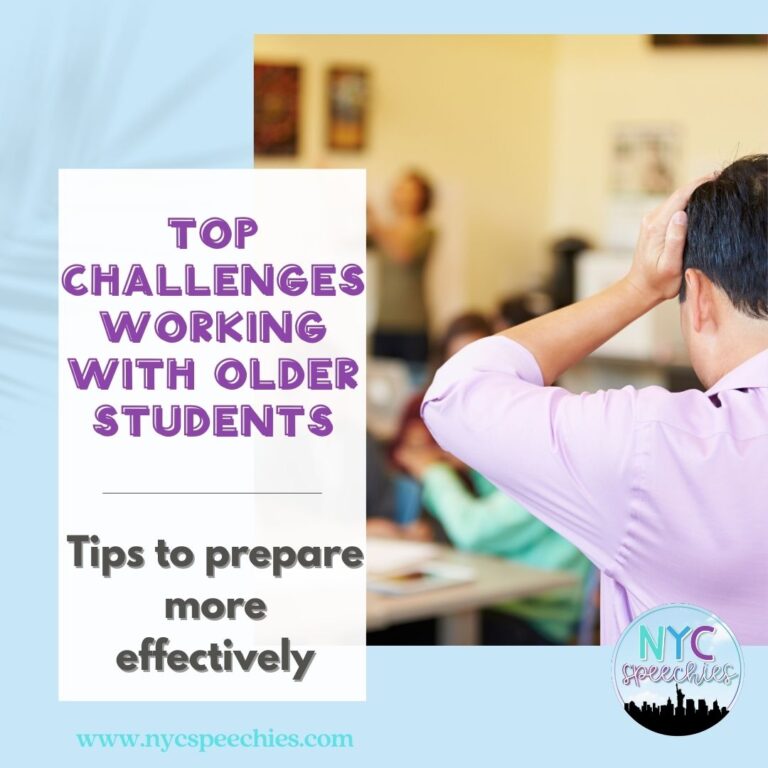Therapy Room to Virtual Room
 Transitioning from the therapy room to tele-therapy has been a challenge not only for our students, but for us as well. We had a routine in place with our students and shifting to remote learning rocked all of our worlds. We were expected to begin tele-therapy right away on platforms we were unfamiliar with. While it was a stressful transition, we adapted and learned so much along the way. We will continue to use much of what we have learned and utilized during remote learning as we move forward into the unknown of the future, whether we continue with tele-therapy, go back to school or follow a hybrid model.
Transitioning from the therapy room to tele-therapy has been a challenge not only for our students, but for us as well. We had a routine in place with our students and shifting to remote learning rocked all of our worlds. We were expected to begin tele-therapy right away on platforms we were unfamiliar with. While it was a stressful transition, we adapted and learned so much along the way. We will continue to use much of what we have learned and utilized during remote learning as we move forward into the unknown of the future, whether we continue with tele-therapy, go back to school or follow a hybrid model.
This journey has made us more confident, organized, and excited as we navigated the virtual world and tele-therapy with our students. We found many advantages to remote learning that we hope to continue to use when we go back to school. We’d like to share what worked for us during remote learning in the hopes of it helping you, too!
Lesson Planning: We had to be a bit more creative when it came to lesson planning to keep our students engaged and motivated in front of a computer screen. Therefore, we created many of our lessons around virtual experiences that were available for free online. We created units that focused on different strategies while we took our students on virtual field trips. We found that embedding links right into our resources allowed students to easily click on the link to access the websites that were used. Check out some of our favorite virtual experiences and the packets that go along with them.
| Virtual Experience Website | Virtual Experience Packet |
| Museums | Virtual Museums |
| National Parks | National Parks |
| Smithsonian’s National Zoo | Zoo Exhibits |
| Georgia Aquarium | Aquariums |
| Tour Builder | Road Trip |
Google Drive:You can do so much on Google Drive! We love how you can organize and color code your folders. Another great feature is the ability to make a copy of a document, rename it with your students name and share it with that student. Once the document is shared with the student, the student can access the document and work on it during our session. It also gives us the opportunity to view what the student is typing in live time and provide the student with feedback. You can provide written feedback in the ‘notes’ section of a slides document. When sharing a document, students can find the document in their ‘Shared with Me’ folder, or their email inbox. You can even copy and paste the shareable link in the chat box during a live video session so the students can easily follow the link to access the document.  Reminders: During the school day, there are so many ways to remind our students about their sessions (paper passes, calling classrooms, sending Remind messages, etc). During remote learning, we needed to find the best ways to remind our students of their session times. We have found these to be the most effective ways to remind our students about their sessions during remote learning:
Reminders: During the school day, there are so many ways to remind our students about their sessions (paper passes, calling classrooms, sending Remind messages, etc). During remote learning, we needed to find the best ways to remind our students of their session times. We have found these to be the most effective ways to remind our students about their sessions during remote learning:
- Google Calendar allows you to schedule and send multiple reminders by creating an event. When creating an event, you are able to schedule reminders through notification or email. These notifications pop up on the students cell phone so they can view it immediately.
- Remind is an app that allows you to contact the student directly through text message. Once a student signs up with Remind, you are able to communicate via text message through the app. Communicating through the app conceals all phone numbers. When reminding a student to join a tele-therapy session, you can also copy and paste the link to join the session in the Remind app so they can easily click on the link to join the video conference.
- Google Voice is a free Google app that gives you a telephone number. This is a way to call or text your students without revealing your phone number. The best part is that you can set your Google Voice to “Do Not Disturb” so you don’t get any calls in the middle of the night or after hours!
Environment Friendly: Less paper and more space! In our therapy room, our students have speech folders filled with work from Freshman year. A Senior would have four years of work in their file – that’s a pretty thick folder! By the end of the year, we can’t fit anymore work into the filing cabinet because it is stuffed to capacity. Since all our students’ assignments are completed in Google Drive, we no longer need folders. All documents are saved in a virtual folder. We also don’t have to make copies in the copy room, saving us both time and paper.
Recording Sessions: It can be useful to refer back to previous sessions to examine your own therapy techniques in your live sessions for your own professional development. Google Meet allows you to record sessions and they are placed directly into a folder in your Google Drive (Zoom also allows recording sessions and they are saved to your computer). We have also used recorded sessions as a reminder of how far our students have come during remote learning. For example, Stephanie recorded sessions with a student who stutters. Not only does referring back to the recorded sessions allow for more accurate data collection, but it also is a visual reminder of how much the student has improved since beginning remote learning.
Screen Sharing: Screen sharing allows you to present your screen to your students. You have total control of what they are viewing and you can show them how to navigate resources or materials. On the flip side, this has also been a helpful feature for students. When students share their screens, you can give them directives to complete a task, locate a document, or even write an email.
Speech and Language Google Classroom: Google Classroom is a great way to provide students with supports and resources, similar to the ones they would have in your therapy room. Here are some of the ways we organized our “Classwork” page to help our students (of course you can organize however you want, that is the beauty of Google Classroom!):
- The “Announcements/School Information” section has important school information and reminders.
- In our “Remote Learning” section, we post our weekly assignments and helpful strategies. Our “Weekly Responses” includes a written response, idiom interpretation, and rubric for easy scoring and data collection. We also posted our helpful strategies and graphic organizers in this section so our students could refer to the strategies while completing work for their other classes. If a student is struggling with an assignment, they have easy access to the strategy needed to help them complete their task.
- The “Organization” tab is where we have all of our helpful Executive Function tools that our students can use to help them stay organized.
- The “Virtual Activities” section is where we post all of our virtual experience resources. When posting these resources as classwork, you can choose to “make a copy” for each student so they automatically have a personalized copy to use during sessions.
Teacher Google Classrooms: We also found it helpful to join our students’ academic Google Classrooms. This was a huge advantage to remote learning. The ability to see all of the assignments that our students are responsible for really allowed us to be more aligned with class expectations. When students were confused on assignments, we were able to access the document to be able to provide them with support. We were able to break down their assignment into smaller steps and create graphic organizers to differentiate the assignment. After task-analyzing the assignment, the document was shared with the teacher and student. Of course, it’s always a good idea to email the teacher to let them know how you are helping the student before you share the modified document with them. Another helpful tip: ask the teacher to add you as a co-teacher! This will allow you to view the student’s assignment and work on it in real time with them in Google Classroom.
Feedback: Student feedback is so important! We take our students’ responses into consideration to help us improve our therapy resources, materials and delivery. We created an ‘End of Year Reflection’ in Google Forms and shared this with our students. Google Forms creates a survey that collects data and creates visual charts of the students’ responses. This information will help guide us as we plan for September and provides great feedback for our supervisor.
Thinking Ahead: During this journey, we found that many of our students were unprepared for tele-therapy and remote learning. They were thrown into this new way of schooling and expectations were high! There are many lessons that we look forward to addressing in September in order to help our students succeed should we continue remote learning. Skills that will be important to target at the beginning of the year include:
- Executive Functioning: Executive Functioning Tools includes daily and weekly homework logs, monthly calendars, to-do lists, schedules, checklists, goal setting, task analysis worksheets, log in information, helpful apps and so much more.
- Following Directions: Google Suite can be very overwhelming with the many apps offered. We want to make sure our students are familiar with navigating all remote learning platforms including: Drive, Docs, Suite, Calendar, Gmail, Classroom, Forms, etc.
- Advocating: How to ask for help during remote learning and who to ask. We learned that many of our students demonstrated difficulty asking for help.
- Email: How to write appropriate emails and the importance of checking email everyday.
- Social Skills: Do’s and Don’ts of Tele-Therapy ← Free Resource!
Throughout these past few months, we were grateful for the ability to connect with our students remotely during a pandemic that caused so much upheaval. We will always remember our group of students who were there with us as we navigated these unknown waters. Seeing our students every day made us smile, provided us with positive daily interactions and connections, and helped us remember why we love our jobs. As we continue through this journey of tele-therapy and online learning, we continue to grow as we step outside our comfort zones. We have learned so much and look forward to further improving our skills as we prepare for the unknowns of September. What have you found to be helpful during remote learning? Did you learn anything new about yourself, your students, or technology? We would love to hear from you – remember we are in this together!







